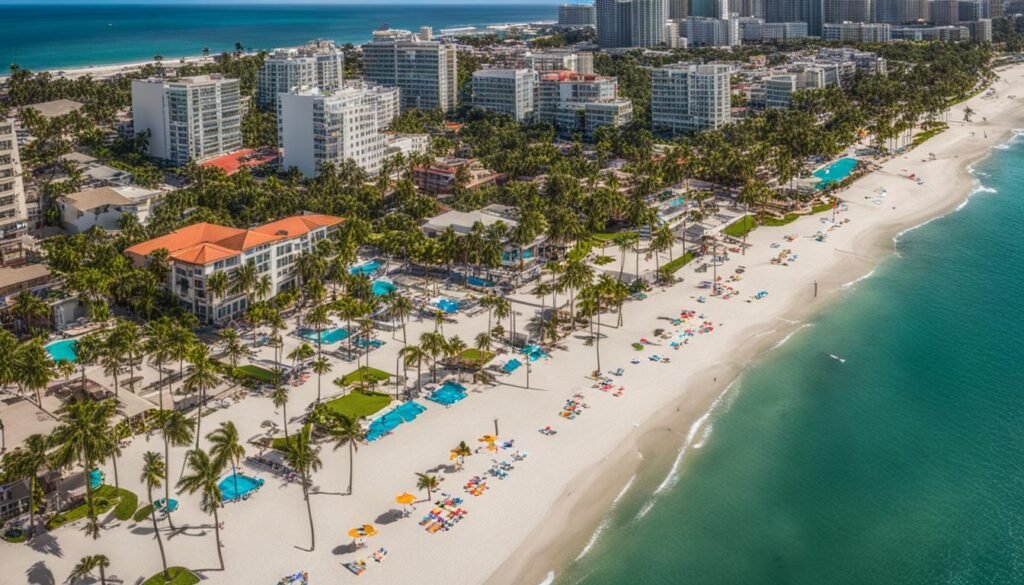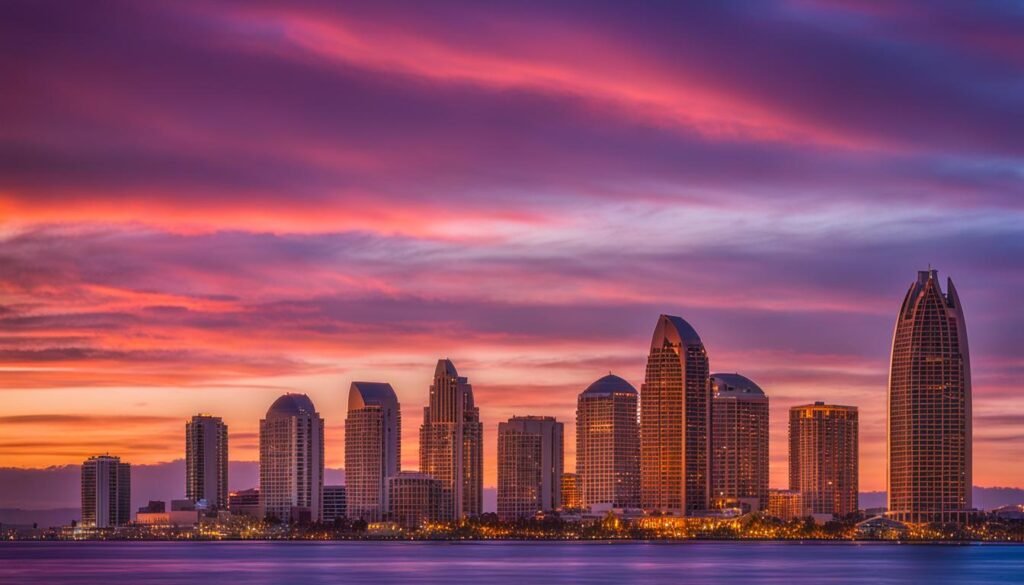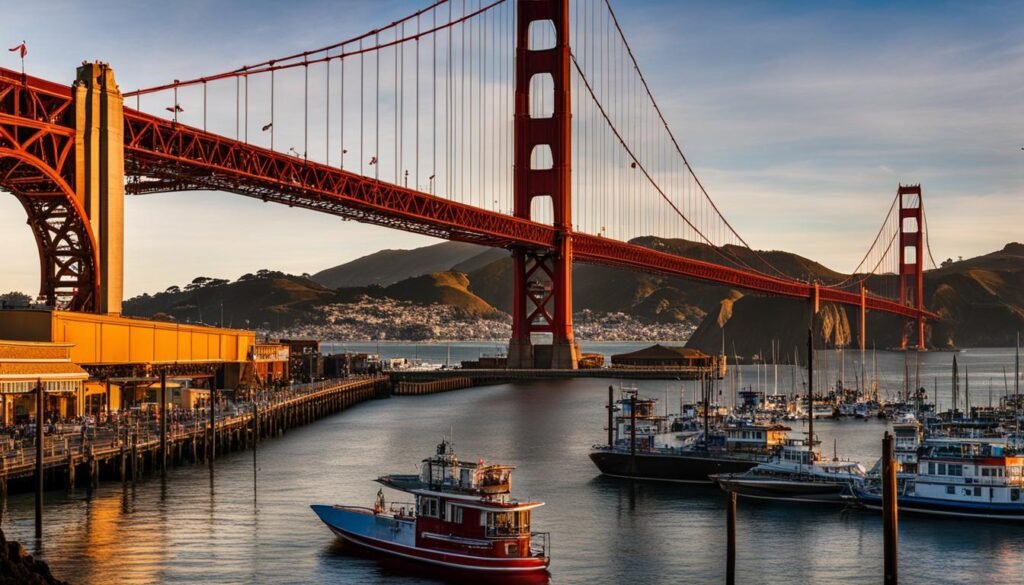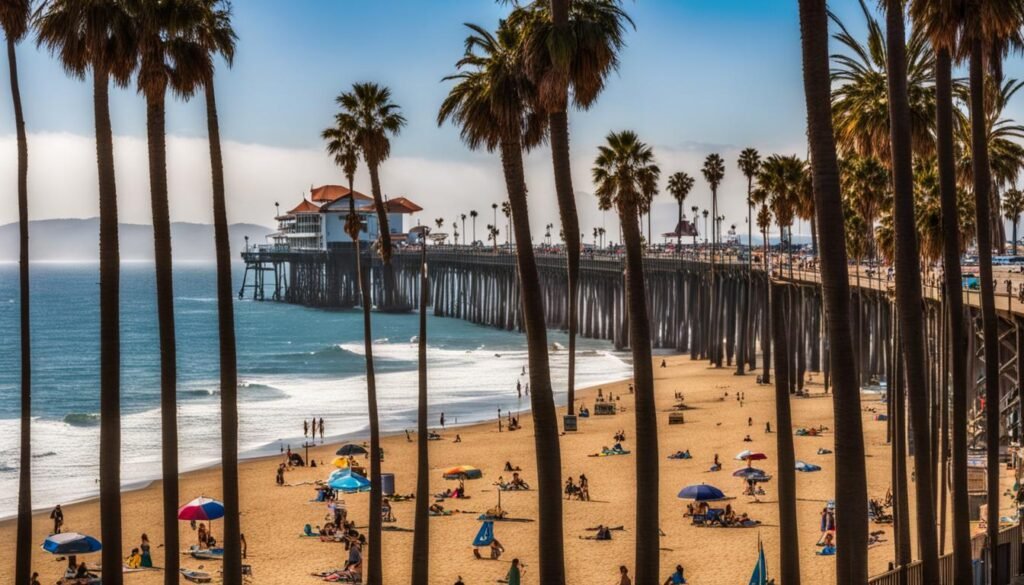Whale watching is an exhilarating experience that allows me to connect with the magnificent creatures of the sea in their natural habitats. As a passionate whale enthusiast, I have explored numerous top-notch destinations across the United States, each offering unique opportunities for unforgettable whale watching experiences. In this ultimate guide, I will share my insights on the best places to spot whales, the perfect time to embark on a whale watching tour, essential tips for a successful adventure, and much more. So, grab your binoculars and join me on this incredible journey into the world of whale watching.
Key Takeaways:
- Discover the best whale watching spots across the United States.
- Learn the optimal season and time for whale sightings.
- Get expert tips for a successful and memorable whale watching experience.
- Understand the importance of responsible whale watching and conservation efforts.
- Explore the rich history and growing popularity of whale watching tours.
The Best Places to Whale Watch in the US
The US is home to numerous incredible whale watching spots. Whether you’re a seasoned whale watcher or a first-timer, these destinations offer unforgettable experiences and the opportunity to see a variety of whale species.
Glacier Bay, Alaska
Famous for its stunning scenery and abundant wildlife, Glacier Bay in Alaska is a prime whale watching destination. Visitors can witness humpback whales breaching and feeding in the rich waters of this national park.
Monterey Bay, California
Monterey Bay is renowned for its diverse marine life, including the majestic blue and humpback whales. You can book whale watching tours from Monterey and catch sight of these incredible creatures in their natural habitat.
Maui, Hawaii
Maui is a paradise for whale enthusiasts. During the winter months, humpback whales migrate to the warm waters of Maui, offering a thrilling sight of their playful behaviors and acrobatic displays.
Cape Cod, Massachusetts
Cape Cod provides an excellent vantage point for observing North Atlantic right whales, one of the rarest whale species. Experience the beauty of these gentle giants while enjoying the scenic coastal views.
San Juan Islands, Washington
The San Juan Islands offer a breathtaking setting for whale watching. Orcas, or killer whales, can be spotted in these waters, along with other species such as Minke whales and gray whales.
Other notable whale watching destinations in the US include Juneau and Kodiak Island in Alaska, Big Sur and Santa Barbara in California, Jacksonville in Florida, Bar Harbor in Maine, Long Island in New York, Virginia Beach in Virginia, Depoe Bay in Oregon, and more. Each location provides its own unique whale watching experience, making it difficult to choose just one.

Whether you’re searching for the best whale watching spots, planning a whale watching tour, or looking for an unforgettable whale watching experience near you, the US offers a wide range of options. Embark on a whale watching trip and witness these majestic creatures in their natural habitat for a truly awe-inspiring adventure.
More Whale Watching Destinations in the US
In addition to the previously mentioned destinations, there are more whale watching spots in the US that are worth exploring. Each location offers unique opportunities to observe whales and provides a memorable whale watching experience.
Cape May, New Jersey
Located in southern New Jersey, Cape May is a charming seaside town renowned for its picturesque beaches and historic Victorian architecture. Whale watchers visiting Cape May can spot humpback whales and fin whales as they migrate along the coast.
Dana Point, California
Nestled in Orange County, California, Dana Point is a popular whale watching destination. Visitors can embark on thrilling whale watching tours, where they have the chance to encounter gray whales, blue whales, and orcas in their natural habitat.
Deception Pass State Park, Washington
Deception Pass State Park, located in Washington state, offers breathtaking views of the Salish Sea and is an ideal location for whale watching. Sightings of orcas, humpback whales, and minke whales are common in this area.
Gloucester, Massachusetts
Gloucester, situated on Cape Ann in Massachusetts, is a historic fishing village that has become a popular whale watching destination. Visitors can witness the impressive sight of humpback whales breaching and feeding in the waters off the coast.
Long Beach, California
Long Beach, California, is not just known for its stunning beaches but also for its incredible whale watching opportunities. Whale watching tours in Long Beach often reveal sightings of blue whales, gray whales, and dolphins.
Kauai, Hawaii
The island of Kauai in Hawaii offers a tropical paradise for whale watching enthusiasts. Visitors can witness the annual migration of humpback whales from Alaska to Hawaii, with the opportunity to see these majestic creatures breach and play.
Kohala Coast, Big Island, Hawaii
Located along the picturesque Kohala Coast on the Big Island of Hawaii, this region is known for its crystal-clear waters and abundant marine life. Whale watchers can glimpse humpback whales as they frolic in the warm Hawaiian waters.
Malibu, California
Malibu, situated along the stunning Pacific coastline of Southern California, offers scenic whale watching opportunities. The waters off Malibu are home to various whale species, including fin whales, gray whales, and even occasional sightings of majestic blue whales.
Myrtle Beach, South Carolina
Myrtle Beach, South Carolina, is a popular destination for both beachgoers and whale watching enthusiasts. From the shores of Myrtle Beach, visitors have the chance to spot bottlenose dolphins and other marine mammals.
Newport Beach, California
Newport Beach, located in Orange County, California, is another prime whale watching destination. Excursions from Newport Beach offer the opportunity to witness the incredible journey of gray whales as they migrate along the coast.
Waianae, Oahu, Hawaii
Waianae, situated on the western coast of Oahu, is a captivating location for whale watching in Hawaii. Visitors can experience the majestic presence of humpback whales as they breach and spout in the beautiful waters of Waianae Bay.
Provincetown, Massachusetts
Provincetown, located at the tip of Cape Cod in Massachusetts, is a renowned whale watching destination on the East Coast. Whale watchers can witness the annual migration of humpback whales, as well as other species such as fin whales and minke whales.
These additional whale watching destinations in the US offer incredible opportunities to observe whales in their natural habitats. Whether on the East Coast, West Coast, or in the tropical paradise of Hawaii, each location provides a unique and unforgettable whale watching experience.

Whale Watching Season in the US
Whale watching season in the US can vary depending on the location. Typically, the best time for whale watching is during the summer months, from June to August. This is when many whale species migrate to feeding grounds, providing ample opportunities for unforgettable whale watching experiences.
Specific whale species and their respective seasons may vary, so it’s important to research the specific destination you plan to visit. Understanding the optimal time for whale watching in that area will greatly increase your chances of spotting these majestic creatures in their natural habitat.
Whether you’re embarking on whale watching trips along the coast of Alaska, exploring the pristine waters of California, or venturing to the islands of Hawaii, knowing the best whale watching spots and the ideal whale watching season will enhance your overall experience.
During the peak whale watching season, you’ll have the opportunity to witness incredible behaviors such as breaching, tail-slapping, and even whale songs. It’s an awe-inspiring sight that will leave you with unforgettable memories of your close encounters with these magnificent marine creatures.
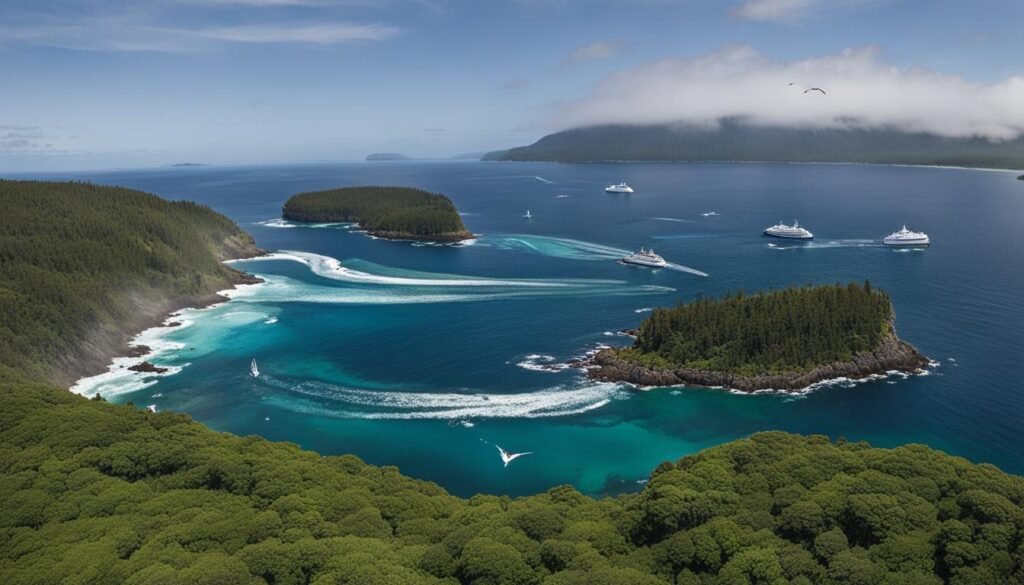
Exploring the US coastline during the prime whale watching season is a fantastic way to appreciate the beauty of nature and the wonder of these gentle giants. So, pack your binoculars, bring your camera, and get ready for an adventure of a lifetime.
Essential Tips for Whale Watching in the US
To have the best whale watching experience in the US, there are some essential tips that I recommend following:
1. Book Your Tour in Advance
To secure your spot and avoid disappointment, it’s best to book your whale watching tour in advance. Popular spots tend to fill up quickly, especially during peak whale watching season.
2. Dress Appropriately for the Weather
Whale watching tours often take place on boats or ships, so it’s important to dress appropriately for the weather conditions. Layered clothing, including a windproof jacket and comfortable shoes, is recommended as temperatures on the water can be cooler.
3. Keep an Open Mind
While whale sightings are common, it’s important to keep an open mind about what you might see. Nature is unpredictable, and whale behavior can vary from day to day. Enjoy the experience and appreciate the wonders of the ocean.
4. Check Trip Logs and Recent Sightings
Prior to your whale watching excursion, check trip logs and recent sightings from the tour operator. This can give you an idea of recent whale activity in the area and increase your chances of spotting these majestic creatures.
5. Bring Essential Items
When heading out on a whale watching excursion, don’t forget to bring essential items such as sunscreen, sunglasses to protect your eyes from the glare of the sun on the water, and chapstick to keep your lips moisturized. These small items can make a big difference in your comfort during the tour.
6. Ask Questions
Make the most of your whale watching experience by asking questions to the knowledgeable guides on board. They can provide fascinating insights into the behaviors and characteristics of the whales you encounter, enhancing your overall understanding and appreciation.
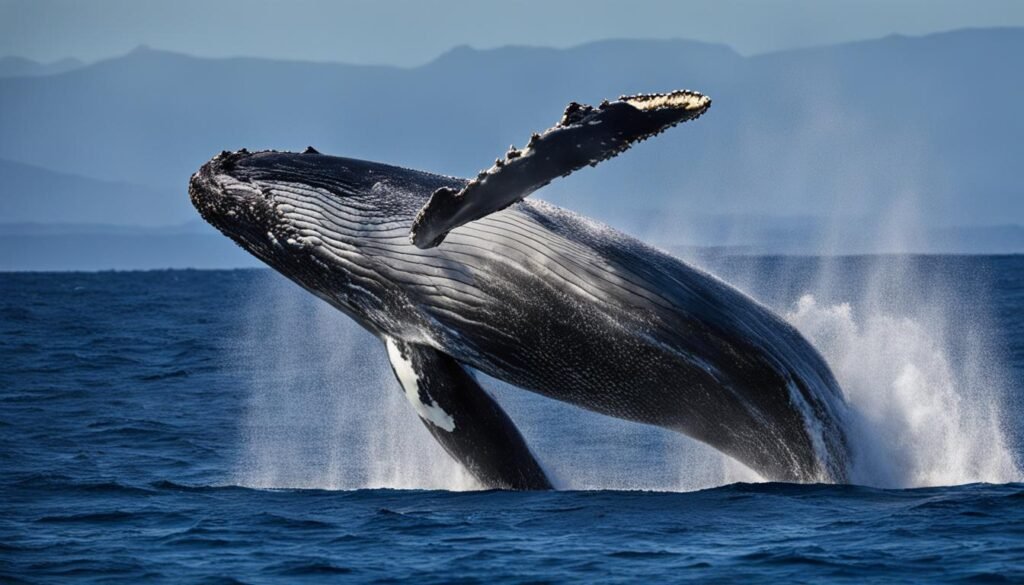
Following these essential tips will enhance your whale watching experience in the US and ensure a memorable encounter with these magnificent creatures. So, book your tour in advance, dress appropriately, keep an open mind, check trip logs, bring necessary items, and ask questions to make the most of your whale watching adventure.
Responsible Whale Watching Tours
Responsible whale watching is essential for the wellbeing of whales and their environment. When I embark on a whale watching tour, I always make sure to choose a responsible tour company that follows guidelines and regulations to minimize the impact on these magnificent creatures.
One of the key factors in responsible whale watching is the use of appropriate vessels. The tour company should prioritize the safety and comfort of both passengers and whales by using vessels that are designed to minimize disturbance and avoid collisions.
Another important aspect of responsible whale watching is having a knowledgeable and experienced crew on board. Guides who are well-versed in cetacean behavior can provide valuable insights and ensure that the tour is conducted in a respectful and educational manner.
Limiting the number of passengers on each tour is also crucial for responsible whale watching. By reducing the overall impact and disturbance caused by human presence, tour companies can provide a more intimate and unforgettable whale watching experience for everyone involved.
Lastly, supporting conservation efforts is an important aspect of responsible whale watching. Many tour companies actively contribute to research, conservation, and educational initiatives that aim to protect and preserve these incredible animals and their habitats.
By opting for a responsible whale watching tour, I not only have the opportunity to witness these majestic creatures up close but also contribute to their long-term survival and the conservation of their ecosystems. It’s a win-win situation that allows me to create unforgettable memories while taking an active role in protecting our marine environment.
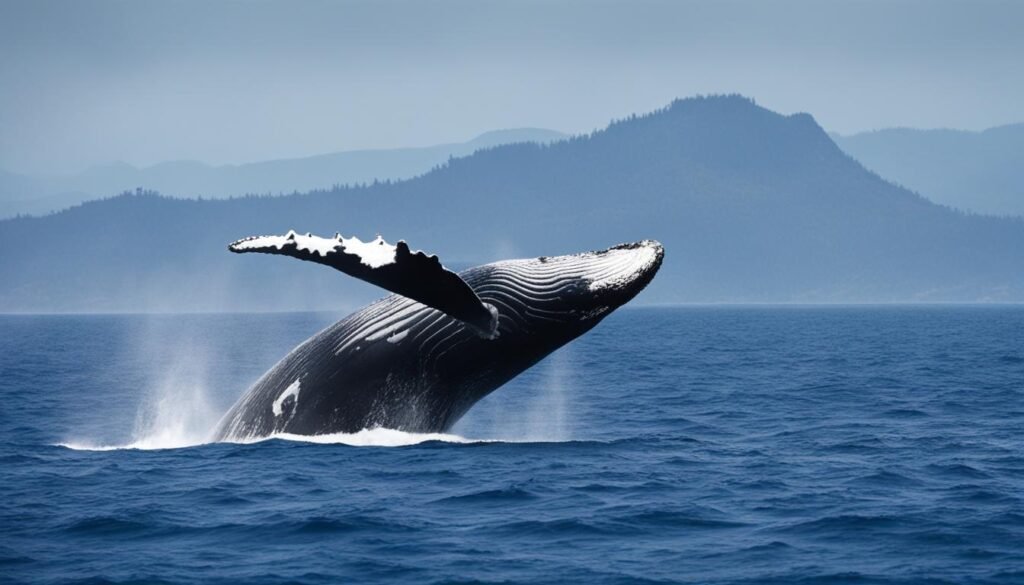
DIY Whale Watching
If you’re the adventurous type and prefer to plan your own whale watching experience, there are a few things to consider to ensure an unforgettable adventure. Here’s a step-by-step guide to help you have a successful DIY whale watching experience:
1. Research the best whale watching spots
Start by researching the best locations for whale watching in the US. Look for areas known for high whale activity, such as the coast of Alaska, California, Hawaii, Massachusetts, and Washington. Each location offers unique opportunities to spot different whale species.
2. Check local regulations and guidelines
Before you head out, familiarize yourself with local whale watching regulations and guidelines. Some areas have specific rules for approaching whales to ensure their safety. Researching in advance will help you understand the dos and don’ts of whale watching in your chosen location.
3. Pack the essentials
Make sure you pack all the necessary essentials for your DIY whale watching adventure. Bring sunscreen to protect your skin from the sun, a hat to shield your face, sunglasses to reduce glare on the water, and lip balm to keep your lips moisturized. Layered clothing is also important, as weather conditions can change quickly near the coast.
4. Bring binoculars
Binoculars are a valuable tool for spotting whales from a distance. Look for a pair with good magnification and lens quality to enhance your viewing experience. They’ll help you spot whale blows, fins, and other signs of whale activity that may be harder to see with the naked eye.
5. Opt for a good vantage point
Choose a good vantage point along the coastline where you have a clear view of the water. Look for elevated areas or cliffs that provide a wide field of vision. Alternatively, if you have access to a boat or kayak, you can venture further offshore for a closer encounter with the whales. Just remember to follow local regulations and keep a safe distance from the whales.
6. Plan your timing
Timing is crucial for successful whale watching. Research the best time of year for whale sightings in your chosen location. Certain months may have higher whale activity due to migration patterns or feeding seasons. Take note of tidal patterns as well, as whales tend to be more active during high tide.
7. Be patient and observant
When whale watching, patience is key. It may take some time before you spot your first whale, so be prepared to wait and observe. Keep an eye out for blows, breaches, and other behaviors indicating whale presence. Pay attention to the patterns of bird activity, as birds will often flock to areas where whales are feeding.
By following these steps and being well-prepared, you can have a rewarding DIY whale watching experience in some of the best whale watching spots in the US.
History of Whale Watching
Whale watching has a rich history that dates back to the mid-20th century. It began with the declaration of the Cabrillo National Monument in San Diego as a public venue for observing the migration of gray whales. Since then, organized whale watching tours have become increasingly popular, spreading along the west and east coasts of the United States. The industry has grown significantly, with millions of people going on whale watching tours each year. The history of whale watching showcases the growing appreciation and conservation efforts for these majestic creatures.

As people became more aware of the beauty and biodiversity of the world’s oceans, the demand for whale watching experiences grew. In response, tour operators began offering specialized trips to prime whale watching locations. These tours provide a unique opportunity for enthusiasts to observe whales in their natural habitat and learn about their behavior and conservation.
Whale watching experiences vary depending on the location and time of year. From the magnificent humpback whales breaching in Alaska to the graceful orcas swimming off the coast of Washington, each encounter offers a different perspective on these incredible creatures. With knowledgeable guides and responsible practices, whale watching tours provide unforgettable experiences that foster a deeper connection with marine life.
Conservation through Education
One of the positive outcomes of the growing popularity of whale watching tours is the increased focus on education and conservation. Tour operators play a vital role in raising awareness about marine conservation issues and promote responsible practices that prioritize the welfare of whales and their natural habitats.
- They provide educational materials and information about the whales and their ecosystems.
- They emphasize the importance of respecting wildlife by maintaining a safe distance and not disturbing their natural behavior.
- They actively support scientific research and conservation initiatives aimed at protecting whale populations.
By participating in whale watching tours, individuals can actively contribute to the preservation of these magnificent creatures and their environments. The revenue generated from these tours helps fund ongoing research and conservation efforts, ensuring the long-term survival of whale species.
The Future of Whale Watching
The future of whale watching looks promising as more people recognize the importance of preserving marine ecosystems and the need for sustainable tourism practices. Continued efforts in education and responsible whale watching will play a crucial role in securing the well-being of whales for future generations.
As technology advances, it is anticipated that new tools and techniques will enhance the whale watching experience. From underwater cameras that provide a glimpse into the secret lives of whales to virtual reality experiences that can bring the wonder of the ocean to landlocked areas, innovation will continue to deepen our understanding and appreciation of these incredible creatures.
Whether you’re a seasoned whale watcher or planning your first excursion, the history of whale watching highlights the immense growth and positive impact of this industry. As we continue to explore the world’s oceans, let us do so with a sense of awe, respect, and a commitment to protecting the remarkable diversity of life beneath the waves.
Tips for Your First Whale Watching Experience
If it’s your first time going whale watching, there are some tips that can help make your experience more enjoyable. Here are some essential guidelines to ensure a memorable and fulfilling first whale watching adventure:
- Dress appropriately: Wear layers and bring a jacket to accommodate changing weather conditions. Don’t forget a hat and comfortable shoes for a day at sea.
- Keep an open mind: Remember, whales are wild animals, and sightings are not guaranteed. Stay patient and enjoy the overall experience of being out on the water.
- Book your tour in advance: To secure your spot and ensure availability, it’s recommended to book your whale watching tour ahead of time.
- Check recent sightings: Before your trip, look at trip logs or check with the tour operator to see recent whale sightings. This can give you an idea of what species you might encounter.
- Bring essential items: Remember to pack sunscreen, sunglasses, and a camera to capture those magical moments on the water.
- Ask questions: Take the opportunity to interact with the knowledgeable guides onboard. They can provide interesting information about the whales and their behavior.
Following these tips will ensure you have an unforgettable first whale watching experience. So, get ready to witness these majestic creatures in their natural habitat and create memories that will last a lifetime.

Supporting Conservation Efforts
Responsible whale watching is not just about enjoying unforgettable whale watching experiences, but also about actively contributing to the long-term survival of these magnificent creatures. Many whale watching tour operators understand the importance of conservation and actively support various initiatives to protect whales and their ecosystems.
By choosing a responsible whale watching tour, you can help support these conservation efforts. These operators often collaborate with research organizations, participate in educational programs, and contribute to fundraising efforts aimed at studying and protecting whales. Their dedication ensures that future generations can also have the privilege of witnessing these incredible animals in their natural habitats.
Research Partnerships
Responsible whale watching operators often enter into partnerships with research organizations to conduct scientific studies and gather valuable data about whales. These partnerships help increase our understanding of whale behavior, migration patterns, and environmental needs. By supporting these operators, you indirectly support research efforts that contribute to the conservation and management of whale populations.
Educational Programs
Many responsible tour companies offer educational programs during whale watching excursions. These programs aim to raise awareness about the importance of whale conservation, promote environmental stewardship, and educate visitors about the marine ecosystem. By participating in these programs, you not only gain a deeper appreciation for whales but also inspire others to become advocates for their protection.
Fundraising Efforts
Whale watching operators committed to conservation often organize fundraising events or contribute a portion of their profits to conservation initiatives. These financial contributions support organizations dedicated to whale research, habitat preservation, and public education. By choosing a tour company that actively fundraises for whale conservation, you directly contribute to these important initiatives and make a positive impact on the future of these magnificent creatures.
Supporting conservation efforts is a crucial part of responsible whale watching. By choosing a tour operator that prioritizes the well-being of whales and actively contributes to their conservation, you can enjoy unforgettable whale watching experiences while making a difference. Together, we can ensure the long-term survival and thriving of these incredible animals and the ecosystems they depend on.
Conclusion
Whale watching is an incredible experience that brings us face to face with the majesty of these gentle giants. By following responsible practices and choosing reputable tour operators, anyone can have a memorable whale watching experience. Whether you opt for a guided tour or plan your own adventure, the United States offers a wealth of whale watching destinations with diverse species to observe.
By supporting conservation efforts and prioritizing the well-being of the whales, we can ensure that future generations will also have the privilege of witnessing these magnificent creatures in their natural habitats. From the best whale watching spots to the top-rated tours, the opportunities to embark on unforgettable whale watching experiences are endless.
So, if you’re looking for the best places for whale watching, the top whale watching destinations, or simply the most unforgettable whale watching experiences, look no further. Book your excursion, pack your camera, and get ready to be in awe of the breathtaking sights and sounds of these magnificent creatures. Whale watching is a journey of wonder and connection with nature that will stay with you forever.
FAQ
What are the best places to whale watch in the US?
Some of the best places to whale watch in the US include Glacier Bay, Alaska; Juneau, Alaska; Kodiak Island, Alaska; Big Sur, California; Monterey Bay, California; San Diego, California; Santa Barbara, California; Jacksonville, Florida; Maui, Hawaii; Cape Cod, Massachusetts; Bar Harbor, Maine; Long Island, New York; Virginia Beach, Virginia; Depoe Bay, Oregon; and the San Juan Islands, Washington.
Are there more whale watching spots in the US?
Yes, there are more whale watching spots in the US that are worth exploring. These include Cape May, New Jersey; Dana Point, California; Deception Pass State Park, Washington; Gloucester, Massachusetts; Long Beach, California; Kauai, Hawaii; Kohala Coast, Big Island, Hawaii; Malibu, California; Myrtle Beach, South Carolina; Newport Beach, California; Waianae, Oahu, Hawaii; and Provincetown, Massachusetts.
When is the best time for whale watching in the US?
The best time for whale watching in the US is generally during the summer months, from June to August, when many whale species migrate to feeding grounds. However, specific whale species and their respective seasons can vary. It’s important to research the specific destination you plan to visit to determine the optimal time for whale watching.
What are some essential tips for whale watching in the US?
Some essential tips for whale watching in the US include booking your tour in advance, dressing appropriately for the weather, having an open mind about what you might see, looking at trip logs and recent sightings, bringing necessary items such as sunscreen, sunglasses, and chapstick, and asking questions to knowledgeable guides.
What should I look for in a responsible whale watching tour?
When choosing a whale watching tour, it’s important to select a responsible tour company that follows guidelines and regulations to minimize the impact on whales. The tour company should use appropriate vessels, have a knowledgeable and experienced crew, limit the number of passengers, and support conservation efforts.
What should I consider when planning my own DIY whale watching adventure?
When planning your own DIY whale watching adventure, consider researching the best times and locations for whale watching, familiarizing yourself with local regulations and guidelines, and ensuring you have the necessary equipment such as sunscreen, a hat, sunglasses, and chapstick.
What is the history of whale watching?
Whale watching has a rich history that dates back to the mid-20th century. It began with the declaration of the Cabrillo National Monument in San Diego as a public venue for observing the migration of gray whales. Since then, organized whale watching tours have become increasingly popular, spreading along the west and east coasts of the United States.
What tips can you give for someone’s first whale watching experience?
For someone’s first whale watching experience, it’s important to dress appropriately for the weather, have an open mind about what you might see, book your tour in advance, look at trip logs to see recent sightings, bring necessary items such as sunscreen and sunglasses, and ask questions to knowledgeable guides.
How can I support conservation efforts through whale watching?
Many responsible whale watching operators actively support conservation efforts through research partnerships, educational programs, and fundraising efforts. By choosing a tour company that contributes to whale conservation, you can help support the long-term survival of these incredible animals and their ecosystems.



